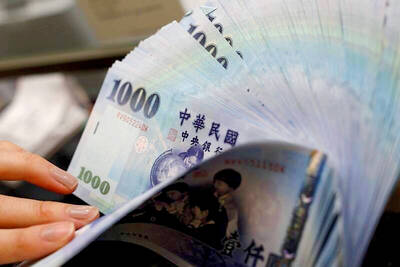Japan and South Korea continue to rack up solid export gains in a sign that the impact of variants of SARS-CoV-2 has yet to have a major impact on global demand, even as the recovery in world trade inches closer to its peak.
Exports out of Japan, the world’s third-largest economy, jumped 49 percent last month from the dismal level of the previous year, while the value of South Korea’s overseas shipments in the first three weeks of this month gained by one-third.
While both figures point to a peaking of gains compared with last year’s very weak performance amid the COVID-19 pandemic, exports continue to gain on a month-on-month basis, an indication that the recovery in global trade still has legs.

Photo: AP
Japan’s shipments were up nearly 10 percent from two years earlier, the biggest gain from 2019 this year.
However, economists cautioned that monthly export gains were also close to plateauing and would be offering less help to global growth in the second half of the year, with the impact of new variants of SARS-CoV-2 still difficult to fully assess.
“The recovery in the global economy is starting to look more like a ‘swoosh’ than a ‘V’,” Korea Institute for Industrial Economics & Trade analyst Cho Chuel said. “The virus variants will weigh on global commerce and temper the views of optimists, who had raised their growth forecasts until recently.”
The Japanese and South Korean data showed that exports to China, and shipments of vehicles and semiconductors continue to pile up gains. China already released figures showing its exports increased 32 percent last month, a slight acceleration from the previous month.
Continued growth in China would be necessary to keep fueling the recovery. Second-quarter growth data suggest Beijing can meet its growth target of more than 6 percent for this year, and continue to drive global demand for commodities and industrial goods.
“Markets have started to get jittery over concerns of further outbreaks, but the economic data isn’t showing a lot of impact from people refraining from activity,” Sumitomo Life Insurance Co economist Hiroaki Muto said. “The hard data from June shows the recovery is holding up.”
Seoul expects record exports this year to drive economic growth to at least 4 percent, a bullish view that has supported Bank of Korea plans to forge ahead with policy normalization this year and to lead rate hikes in Asia.
However, that outlook is becoming less certain as the spread of the more contagious variants of SARS-CoV-2 thwarts plans to lift restrictions in many economies, including South Korea itself.
In Japan, even with an acceleration of vaccinations, an uptick in COVID-19 infections has landed Tokyo in its fourth state of emergency and barred fans from the Olympic Games.
A spectator-less Games has subdued the mood for an event that was earlier hoped to serve as a psychological turning point for the world in the fight against COVID-19.
“Asia overall is getting roiled by the new [Delta] variant and it’s been difficult for the region to return to where it was before the pandemic,” IHS Markit economist Harumi Taguch said. “Both in and outside Japan, the recovery pace is dependent on the vaccination pace.”

Merida Industry Co (美利達) has seen signs of recovery in the US and European markets this year, as customers are gradually depleting their inventories, the bicycle maker told shareholders yesterday. Given robust growth in new orders at its Taiwanese factory, coupled with its subsidiaries’ improving performance, Merida said it remains confident about the bicycle market’s prospects and expects steady growth in its core business this year. CAUTION ON CHINA However, the company must handle the Chinese market with great caution, as sales of road bikes there have declined significantly, affecting its revenue and profitability, Merida said in a statement, adding that it would

MARKET LEADERSHIP: Investors are flocking to Nvidia, drawn by the company’s long-term fundamntals, dominant position in the AI sector, and pricing and margin power Two years after Nvidia Corp made history by becoming the first chipmaker to achieve a US$1 trillion market capitalization, an even more remarkable milestone is within its grasp: becoming the first company to reach US$4 trillion. After the emergence of China’s DeepSeek (深度求索) sent the stock plunging earlier this year and stoked concerns that outlays on artificial intelligence (AI) infrastructure were set to slow, Nvidia shares have rallied back to a record. The company’s biggest customers remain full steam ahead on spending, much of which is flowing to its computing systems. Microsoft Corp, Meta Platforms Inc, Amazon.com Inc and Alphabet Inc are

RISING: Strong exports, and life insurance companies’ efforts to manage currency risks indicates the NT dollar would eventually pass the 29 level, an expert said The New Taiwan dollar yesterday rallied to its strongest in three years amid inflows to the nation’s stock market and broad-based weakness in the US dollar. Exporter sales of the US currency and a repatriation of funds from local asset managers also played a role, said two traders, who asked not to be identified as they were not authorized to speak publicly. State-owned banks were seen buying the greenback yesterday, but only at a moderate scale, the traders said. The local currency gained 0.77 percent, outperforming almost all of its Asian peers, to close at NT$29.165 per US dollar in Taipei trading yesterday. The

The US overtaking China as Taiwan’s top export destination could boost industrial development and wage growth, given the US is a high-income economy, an economist said yesterday. However, Taiwan still needs to diversify its export markets due to the unpredictability of US President Donald Trump’s administration, said Chiou Jiunn-rong (邱俊榮), an economics professor at National Central University. Taiwan’s exports soared to a record US$51.74 billion last month, driven by strong demand for artificial intelligence (AI) products and continued orders, with information and communication technology (ICT) and audio/video products leading all sectors. The US reclaimed its position as Taiwan’s top export market, accounting for